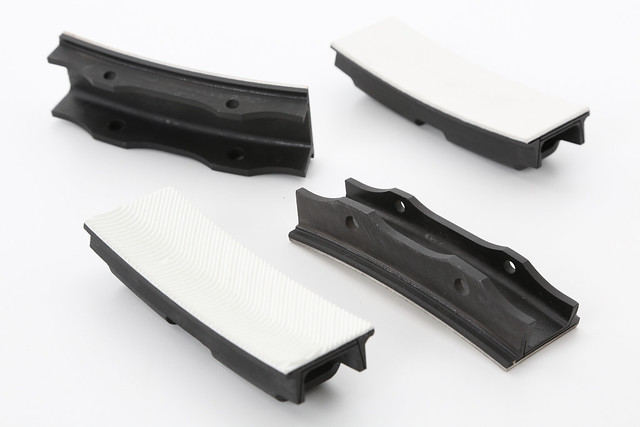Ceramic Matrix Composites: Properties, Production, and Applications
Ceramic matrix composites are a type of composite with ceramics as both the reinforcement and the matrix material. The reinforcement provides its special properties while the matrix material holds everything together. These composites were developed for applications with demanding thermal and mechanical requirements, such as in aerospace vehicles, nuclear industries, ground transportation, space structures and chemical industries [1].
What are ceramic matrix composites?
Ceramic matrix composites (CMC) are generally made from ceramic fibres or whiskers embedded in a ceramic matrix. These ceramics cover a varied range of inorganic materials that are usually non-metallic and commonly used at high temperatures. Ceramics can be classified into two classes [1]:
- Traditional or conventional ceramics – which usually are in monolithic form. They include tiles, bricks, pottery, and a wide range of art materials.
- Advanced or high-performance ceramics – which often undergo chemical processing to be derived. These include nitrides, oxides, and carbides of aluminium, silicon, zirconium, and titanium.
CMC reinforcing materials
Reinforcing materials used for ceramic matrix composites include carbon, alumina, silicon carbide and alumina-silica. The refractory fibre can be in the form of whiskers, particles, long or short fibres, and nanofibres. These fibres have a polycrystalline structure similar to that of conventional ceramics.
Continuous or long fibres provide better toughness as they can support a load even after the ceramic matrix undergoes cracking, thus slowing down the crack’s propagation. Short fibres and whiskers, on the other hand, give improved resistance to crack growth. This makes composites less sensitive to flaws, yet once a crack begins to propagate, failure could be disastrous [2].
CMC matrix materials
The matrix materials used are the same as the reinforcements stated above, with the addition of non-oxide, ultra-high-temperature (UHT) ceramics used for special applications. The advanced ceramics are commonly used in the production of ceramic matrix composites to overcome the main disadvantage of traditional ceramics; namely, their brittleness. The most commonly used CMCs are non-oxide CMCs, such as carbon/silicon carbide (C/SiC), carbon/carbon (C/C), and silicon carbide/silicon carbide (SiC/SiC). Generally, their names follow the fibre material type/matrix material type structure [1].
Properties of ceramic matrix composites
Conventional ceramics have limited thermal shock resistance and low fracture toughness. These drawbacks are addressed by the use of fibre-reinforcement in ceramic matrix composites.
Common properties of ceramic matrix composites are [3]:
- High thermal shock and creep resistance
- High temperature resistance
- Excellent resistance to corrosion and wear
- Inertness to aggressive chemicals
- High tensile and compressive strength, thus no sudden failure as compared to conventional ceramics
- Increased fracture toughness due to reinforcement
- Lightweight due to reduced density
- High strength retention at elevated temperatures
Production of ceramic matrix composites
Ceramic matrix composites are made using ceramic fibres of 3 to 20 micrometres in thickness. The small diameter allows flexibility of the fibre (usually manufactured as yarns) when further textile processing is needed. CMC preform is made from the fibres by textile structuring of continuous fibres through weaving, braiding and knitting or by cutting the yarns and forming short fibre bundles.
Ceramic matrix composites reinforced with continuous fibres are commonly fabricated by infiltration methods, in which a ceramic matrix is formed by a fluid infiltrating the fibrous structure. The conversion of fluid into ceramics varies according to the type of fluid used and the processes involved. Some infiltration techniques are as follows [3], [4]:
- Liquid silicon infiltration (LSI)
- Polymer infiltration and pyrolysis (PIP)
- Ceramic slurry infiltration (CSI)
- Chemical vapour infiltration (CVI)
- Reactive melt infiltration (RMI)
Applications of ceramic matrix composites
Common applications of ceramic matrix composites are [4]:
- Heat exchangers and burner components
- Gas turbine components – these include turbine blades, combustion chambers, stator vanes and turbine engines, where coated silicon carbide fibres are embedded in a ceramic matrix to impart temperature resistance, toughness, and low density.
- Aerospace industry – including body flaps, shrouds and space shuttle shielding, where coated ceramic tiles provide protection from extreme heat.
- Engine exhaust systems – including ceramic exhaust nozzles for commercial aircraft to increase component life and reduce weight and engine noise.
- Hypersonic vehicles – these utilise structural materials such as ultra-high-temperature ceramics, which make good candidates for high heat flux areas.
- Nuclear power industry – including internal reactor structures made from MAX phase composites that can withstand high temperatures and have high mechanical damage tolerance and good chemical compatibility with coolants such as sodium and molten lead.
Sources
[1] K.K. Chawla, 1993, Ceramic Matrix Composites, London: Chapman & Hall
[2] “What Are Ceramic Matrix Composites?”, 2018, from: https://llfurnace.com/blog/what-are-ceramic-matrix-composites/
[3] “Ceramic Matrix Composites – an Alternative for Challenging Construction Tasks”, 2013, Ceramic Applications, pp.45-9.
[4] I.M. Low, 2018, Advances in Ceramic Matrix Composites, UK: Woodhead Publishing
